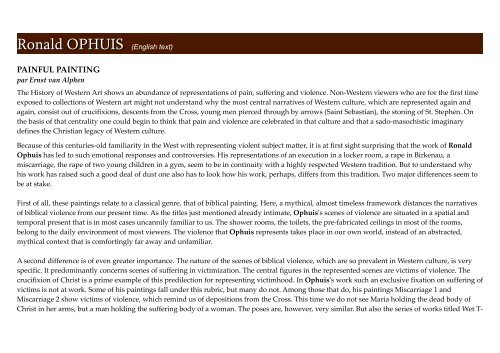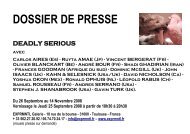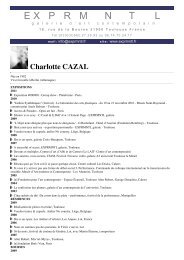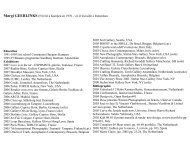Ronald OPHUIS (English text) - Exprmntl
Ronald OPHUIS (English text) - Exprmntl
Ronald OPHUIS (English text) - Exprmntl
- No tags were found...
Create successful ePaper yourself
Turn your PDF publications into a flip-book with our unique Google optimized e-Paper software.
<strong>Ronald</strong> <strong>OPHUIS</strong> (<strong>English</strong> <strong>text</strong>)PAINFUL PAINTINGpar Ernst van AlphenThe History of Western Art shows an abundance of representations of pain, suffering and violence. Non-Western viewers who are for the first timeexposed to collections of Western art might not understand why the most central narratives of Western culture, which are represented again andagain, consist out of crucifixions, descents from the Cross, young men pierced through by arrows (Saint Sebastian), the stoning of St. Stephen. Onthe basis of that centrality one could begin to think that pain and violence are celebrated in that culture and that a sado-masochistic imaginarydefines the Christian legacy of Western culture.Because of this centuries-old familiarity in the West with representing violent subject matter, it is at first sight surprising that the work of <strong>Ronald</strong>Ophuis has led to such emotional responses and controversies. His representations of an execution in a locker room, a rape in Birkenau, amiscarriage, the rape of two young children in a gym, seem to be in continuity with a highly respected Western tradition. But to understand whyhis work has raised such a good deal of dust one also has to look how his work, perhaps, differs from this tradition. Two major differences seem tobe at stake.First of all, these paintings relate to a classical genre, that of biblical painting. Here, a mythical, almost timeless framework distances the narrativesof biblical violence from our present time. As the titles just mentioned already intimate, Ophuis's scenes of violence are situated in a spatial andtemporal present that is in most cases uncannily familiar to us. The shower rooms, the toilets, the pre-fabricated ceilings in most of the rooms,belong to the daily environment of most viewers. The violence that Ophuis represents takes place in our own world, instead of an abstracted,mythical con<strong>text</strong> that is comfortingly far away and unfamiliar.A second difference is of even greater importance. The nature of the scenes of biblical violence, which are so prevalent in Western culture, is veryspecific. It predominantly concerns scenes of suffering in victimization. The central figures in the represented scenes are victims of violence. Thecrucifixion of Christ is a prime example of this predilection for representing victimhood. In Ophuis's work such an exclusive fixation on suffering ofvictims is not at work. Some of his paintings fall under this rubric, but many do not. Among those that do, his paintings Miscarriage 1 andMiscarriage 2 show victims of violence, which remind us of depositions from the Cross. This time we do not see Maria holding the dead body ofChrist in her arms, but a man holding the suffering body of a woman. The poses are, however, very similar. But also the series of works titled Wet T-
shirt contest, the Suicide of Mala Zimetbaum before her Execution, Chechen, Prisoner of War, Two Dead Bodies, Srebrenica 1, Srebrenica July 1995,are in continuity with the Western tradition of representing scenes of suffering, even if we do not recognize traditional formal poses in them. Theyare in continuity with that tradition because their central element is the body, whether alive or dead, as index of the suffering felt within that body.The Bloody T-shirts in Wet T-shirt contest also function as indexes, in this case of the tortured bodies, which they once clothed. These T-shirts alsomobilize traditional imagery; they remind us of the cloth of Veronica, bearing the imprint of Christ's blooded and sweated face.Victims and PerpetratorsThe representation of suffering victims can be considered uplifting. Scenes of suffering are usually meant to produce empathy in viewers. They areencouraged to identify with the suffering victim. By means of this kind of identification viewers are stimulated to imagine what the suffering ofanother person means, indeed, even what it feels like. This kind of identification is possible because it does not take place in a vacuum. Theempathic identification with victimhood is embedded in a narrative sequence of events. Something has lead to the victimization of this sufferingperson and ultimately there will be a resolution of this situation. The represented scene is part of a narrative that operates within a given set ofconventions within which social and political problems must be resolved. Ultimately, these scenes of victimhood function within a fixed morality.It is the moral, narratively normalized framework in which these scenes are embedded that determines that the suffering person is a victim andtherefore without guilt. This explains why the stimulated empathic mode of looking to such scenes of suffering is ultimately utterly comforting. Thecomfort is produced by the act of identification. The identification with the represented victim posits its viewers also without guilt and reconfirmstheir conventional morality.So far, the paintings I have discussed can be recognized as within the Western tradition of painting. The paintings for which Ophuis is mostlyknown and contested are, however, representations of violence that focus predominantly on the perpetrators. This is one reason for theirscandalous reception. In Execution, Boy with Gun, Sweet Violence, Footballers 1, Birkenau 1, and Birkenau 2 the viewer's attention is mainlydirected to the perpetrators of violence, not to its victims. The kind of vision that is stimulated or enabled by these works is of a completely differentorder than the one discussed above. Here, one is encouraged to imagine oneself in a situation or position one does not want to be in. At the sametime it is not clear in what kind of sequence of events these scenes can be embedded. Do these paintings celebrate or condemn the perpetratedviolence? Ultimately, the answer to this question depends on the narrative sequence of events that can be extrapolated from the represented event.In this respect the paintings are highly ambiguous: they do not provide an answer to what kind of closure will follow. This ambiguity results in astrong moral appeal to the viewer. The viewer cannot follow, or identify with, the moral position implicated by the painting. Instead, the paintingforces the viewer to consider moral positioning in itself.
In order to understand how Ophuis's "perpetrator paintings" work, that is, relate to the viewer, one is best off situating them within the tradition ofhistory painting, of which biblical painting is sometimes considered a subgenre. History painting is also a narrative genre. A good example in thistradition is Francisco de Goya's The Third of May, 1808, from 1814. This painting condenses in one single image a whole sequence of events. In thecentre we see the execution of a man, his arms lifted, reminding us of Christ hanging at the Cross. At the left of him we see an earlier stage ofexecution: some men who are waiting for their execution; and right of him some bloody fallen figures after their execution. From right to left thissingle painting represents a progression in time. Ultimately these three different phases in the execution remind us of the different Stations of theCross. The open-armed gesture of the man in the middles makes this association almost explicit. This association with Christ and the Stations of theCross is also emphasized by light, by the intensification of color, and by how differences in light signify different phases in time. The men beingexecuted are the light-revealed climax of the painting, whereas those still waiting for their execution are in a grey undifferentiated background andthose already fallen are at the left-hand edge of the painting again less lightened than the execution itself. One single image presents the unfoldingof time. Thus, the historical events of the Third of May are absorbed into metaphysical time. The represented events become an allegory for aneternal, human situation. Christ's Passion frames the rebels of Madrid and the impact of their representation is metaphysical and moral. Thespecificity of the historical events is ultimately framed as an allegory about the eternal inhumanity of man to man.Edouard Manet's history painting The Execution of Emperor Maximilian from 1867 represents a similar narrative. Emperor Maximilian is executedin Queretaro in Mexico by a squad of soldiers. The emperor is not the focused centre of the paining like the man with the lifted arms is in the Goyapainting. His position as victim is not foregrounded by the composition and by the distribution of light; it can only be derived from the representedplot. Most of the viewer's attention goes to the soldiers who fire their arms on the emperor. Also in contrast with the Goya painting, no sequence ofevents can be read from the image. There are no clues of a pre-history, or of a closure. There is no dramatic lightening that suggests an unfolding oftime. The narrative dimension of this realist painting is not transformed into a metaphysical or moral one. All we see is one single moment, a slice oftime, without indications for the viewer how to evaluate the event morally. This lack of a metaphysical and moral dimension was the "scandal" ofrealism. Contemporary critics accused Manet (and other realist painters) of lack of feeling, of the inability to comprehend, or to create a pictorialequivalent for the moral and psychological implications of a chillingly brutal event, as had Goya in his Third of May. [i]When we try to understand Ophuis's works in relation to the tradition of history painting, it is clear that in terms of their representation of violentevents they should be seen as following the realist mode of history painting. The metaphysical and moral dimensions that frame classical historypaintings like Goya's are utterly missing in his depictions of brutal scenes. The lightening in his paintings, for instance, is like in the realist traditionutterly non-dramatic. There is no striking distribution of light between light and dark areas. The representational space looks like present-daypublic spaces lightened by neon light. The light is equally bleak everywhere. In Ophuis's works light is no device that helps the viewer tounderstand the depicted scenes narratively or morally. But alleging respected historical predecessors like Manet and other realist painters is notenough to understand and to legitimize his project of representing scenes of violence at the beginning of the 21st century.
It is rather surprising that in many of the critical responses to Ophuis's work the nineteenth century paradigm of Manet's contemporary critics canbe recognized. In 150 fifty years the expectations of viewers seem to have remained unchanged. This position is made clear in one of the mostintelligent and articulate responses to Ophuis's paintings. In his response, Willem Jan Otten characterizes Ophuis as a "contemporary debunker ofall Meaning". His paintings are supposed to be utterly "literal". The literality of his paintings would imply that they do not evoke a larger "Plan".He [Ophuis] fits perfectly in a culture that assumes it can manage itself without a Plan, and that any effort to see in suffering something else thanuseless misery is called a poor excuse for consolation. Ophuis is in search of reality itself. The senseless, dismantled reality that is deprived of anysignificance.[ii]The "Plan" Otten is referring to is clearly the metaphysical dimension, which provides us also with moral standards. Whereas the nineteenthcentury realists already contested this paradigm, it is still used in the twentieth first century in order to condemn Ophuis's work. In this respect it isalso significant that Otten makes an exception for those paintings that represent suffering and victimhood, like the painting Miscarriage. Hedescribes this painting as a "disabled painting, in which something invisible is caught: the effort of the man, sitting behind the woman, to holdsomebody who is suffering in his arms. It is a reversed pieta". [iii] This painting of victimhood he admires. Typically, the negative judgments – thepaintings without "Plan" – are all directed against those paintings that pay attention to violent perpetrators instead of victimhood.The Appeal to Moral PositioningTo understand these judgments, another backdrop must be invoked. Ophuis's work cannot only be related to the tradition of history painting, butalso to the mass medium of journalist photography and fiction film. In the 21st century, representations of atrocity and suffering do rarely figureanymore in the realm of high art. They have become the privileged subject matter of mass media. And although mass media like documentaryphotography are usually seen as realistic par excellence, it may be surprising that journalist photographs have usually more in common withclassical history paintings like Goya's than realist paintings like Manet's. In most journalist photographs of atrocities witnessing bystanders areincluded in the image and it is their response of horror that tells the viewer how to respond psychologically and morally to the documented events.And action films that take delight in excessive violence as an end in itself are usually rounded off with a closure in which the bad guy is killed orcaught and the good guy is rewarded. Unconvincing as such closures may be, they fulfill society's official precept to morally condemn violence andto show that violence does not pay off.An exceptional film, which in important respects can be compared to Ophuis's paintings, is David Fincher's film Fight Club from 1999. LikeOphuis's paintings this film has been very controversial and the controversies all focus on its supposed amorality. The problem is that the film isnot explicit in it evaluation of the excessive violence it shows. Should the film be read as legitimating and celebrating primitive male fantasies or as
a critique of the consequences of contemporary consumption culture? Both arguments have been made. Is the film reactionary, or progressive? Bothclaims have been made. The film gives no answer to these questions and the viewer is compelled to make her own moral judgment. The scandal ofthis film is, it seems, not just its abundance of violence, but the fact that it refuses the viewer an unambiguous message or judgment that makes theviolence understandable, whether it is from a progressive position or a conservative position.[iv] Ultimately the responses to this film,and also toOphuis's work, are symptomatic for what Western viewers and readers expect from representations. A representation is supposed to be much morethan just an image, a sequence of events, or a source of information. It should also direct the viewer in how to process or digest the representation,especially when it concerns controversial and contradictory issues such as violence.In relation to the majority of mass media representations, Ophuis is as exceptional as Fincher. Ophuis is not performing a representational practicethat is already done, and much more adequately done, by the "new" photographic and filmic media. Indeed, within the mass media, Fincher's filmis as exceptional as Ophuis's paintings are within the world of painting. Ophuis's "realist" depictions of atrocities are still as shocking andcontroversial as such depictions were for the contemporary critics of Manet and other nineteenth century realists. This leaves us with the questionhow we can understand and legitimize this painterly practice of representing violent atrocities? And, given the spread of mass media, what does itmean that he chose the medium of painting for his depictions of this violence, instead of, for example, making a film or an opera about it? In otherwords, what does paint do in relation to its subject matter?Unfelt FeelingsIn a discussion with art critic Anna Tilroe, philosopher Henk Oosterling and curator Bartomeu Marí on painting today, Ophuis himself provides analternative for thinking about images in terms of their "implied" morality. This alternative is of crucial importance because it enables us to reflect onimages beyond the issue of message or moral. This does not mean that this alternative is amoral but that it suspends the issue of morality in orderto deal with other issues. Resisting the inclination of one of the discussants to reduce images to the information they provide, Ophuis proposes toapproach the image from a psychological point of view. He tells an anecdote. When he was three years old his brother died. Later, this was for him acompletely abstract event. He did not have any images of it. He had never known his brother. So, he made up some images of the death of hisbrother by means of which he could evoke some form of grief. Those images were fictional and they did not contain much information, but theywere able to trigger feelings of sorrow. Even at moments that he did not want to be sad, just the sight of these images could make him feel sad.[v]This example suggests first of all that images function not only as providers of content or messages, moral or not, but that they are alsoindispensable in raising feelings and working through them. Images are able to do that because they possess a concreteness that knowledge,consciousness, or propositional content do not have. The latter aspects are rather abstract or general. But the second implication of this example is
even more fundamental. Ophuis had lost his brother and according to conventional morality to lose a family member is "sad". The moralconclusion implied by the narrative event, is, however, of little weight when this morality is not accompanied by feeling; when it is not felt. Whenthe moral conclusion is only produced by a conventional logic, it is emptied out at the same moment that it is reached. According to Ophuis'sexample one needs the concreteness of images in order to feel and substantiate moral conclusions. Later in the discussion, Ophuis stresses theimportance of visualization also in the con<strong>text</strong> of reading literary and other kind of <strong>text</strong>s. For him <strong>text</strong>s only really become significant when heimagines visual images on the basis of these <strong>text</strong>s. With the <strong>text</strong> he reads go images.[vi]The example of the death of Ophuis's brother leaves open the question what it can mean, or do, to provide the violence of perpetrators theconcreteness of an image. For, his example concerns victimhood in a double sense: the death of his brother, and he himself losing his brother. Butwhat do we feel when we watch a scene in which three men sexually abuse children, as in Ophuis's painting "Sweet Violence", and why should webe encouraged to feel what these men feel? Let me probe this issue of identifying and feeling "with" the perpetrator through a discussion ofdifferent forms of identification.A Poison that CuresOphuis's work solicits a form of identification that is not only different in target, but also qualitatively different from what we usually understandby identification. Kaja Silverman has argued that identification takes one of two forms.[vii] One form involves taking the other into the self on thebasis of a (projected) likeness, so that the other "becomes" or "becomes like" the self. Features that are similar are enhanced in the process; featuresthat remain irreducibly other are cast aside or ignored. This form of identification is called idiopathic identification. The other form is heteropathic.Here, the self doing the identification takes the risk of—temporarily and partially—"becoming" (like) the other. This is both exciting and risky,enriching and dangerous, but at any rate, affectively powerful.In the case at hand, it can be argued that identification with victims, like in the two Miscarriage paintings or Death and Mourning, although usefulin realizing their horror, is also a way of reassuring viewers, perhaps unduly, of their fundamental innocence. In contrast, soliciting partial andtemporary identification with perpetrators makes one aware of the ease with which one can slide into a measure of complicity. To raise thepossibility of such identification with the fundamental, cultural other is appealing to heteropathic identification. Precisely because artworks are not"serious", because they are fictional, art is so eminently suitable to solicit such heteropathic identification, which begins to blur overly rigidboundaries between guilt and innocence.To explain how these imaginative attempts to work through violence work, two ways of handling loss must be distinguished. I am referring to the
distinction made by Eric Santner between "narrative fetishism" and mourning. He defines narrative fetishism as the construction and deployment ofa narrative consciously or unconsciously as a defense mechanism. Such narratives are mobilized to expunge the traces of the trauma or loss thatcalled that narrative into being in the first place. The work of mourning, on the contrary, is a process of elaborating and integrating the reality of lossor traumatic shock by remembering and repeating it in symbolically and dialogically mediated doses. It is a process of translating, troping andfiguring loss.[viii] Although in Ophuis's work it is not loss but rather violence that is at stake, Santner's distinction is highly relevant becauseOphuis's work could be described as "elaborating and integrating the reality of [violence] by repeating that violence symbolically andimaginatively".Santner uses Freud's discussion of the fort/da game in Beyond the Pleasure Principle to explain the mechanisms of mourning. Freud observed thefort/da game in the behavior of his one and a half year old grandson. In this game the child was able to master his grief over his separation from hismother by staging, play-acting, his own performance of her disappearance. (She was gone—fort: then she was there—da.) This little boy, we cannow see, was involved in heteropathic identification with the person who was, in his everyday drama, the "perpetrator," the mother who left him.He did so by repetition, using props that D.W. Winnicott would call transitional objects. This game is based on a ritualized mechanism of dosingout and representing absence by means of substitutive figures. In the words of Santner:The dosing out of a certain negative—a thanatotic—element as a strategy of mastering a real and traumatic loss is a fundamentally homeopathicprocedure. In a homeopathic procedure the controlled introduction of a negative element—a symbolic or, in medical con<strong>text</strong>s, real poison—helps toheal a system infected by a similar poisonous substance. The poison becomes a cure by empowering the individual to master the potentiallytraumatic effects of large doses of the morphologically related poison. In the fort/da game it is the rhythmic manipulation of signifiers and figures,objects and syllables instituting an absence that serves as the poison that cures.[ix]The heteropathic identification with the perpetrator is effectuated through the role of the victim. In the case of Freud's grandson, it was the child'sown drama that was enacted.Ophuis's representations of perpetrating violence should also be seen as examples of poison that cures. His homeopathic art practice functions as acounterweight against the daily doses of horror stories disseminated by television, radio, newspapers, and other mass media. This counter poison isnecessary because the endless distribution of atrocity stories has ultimately a numbing effect on readers and viewers. We get to know whathappened but it does not affect us anymore. The narrative and moral framework in which these events are embedded program the right response:"horrible". But what "horrible" means, that is, how it feels affectively, is hard to know. Ophuis's works consist of affective images instead ofinformative images. A moral framework does not neutralize the poison they administer. So, the poison must be felt, confusing and difficult as thatis.
Affective knowledgeOphuis's paintings of perpetrating violence that have raised most controversy are those in which sexual violence is at stake. Paintings like SweetViolence, Footballers 1, Birkenau 1, Footballers 2, and Execution are representing sexual violence or are loaded with sexual tension. Other paintingsshowing scenes of perpetrating violence can be understood as part of war situations, e.g. Boy with Gun. The representations of sexual violence andabuse are bodily affective in a double sense: they deal with sexual pleasure and with pain. The events the viewer is invited to experience are totallyset in the realm of affect and the physical: eroticism, sexual pleasure, torture and death. Such experiences are bodily. This is precisely the point. Thecombination of violence with sexuality makes it almost inevitable that the viewer will be affected. In contrast, being affected by war violence canmore easily be kept at bay by assuming that this kind of violence only takes place far away. And although Ophuis's paintings are not framed byconventional morality, the viewer can always rely on the comfort of that morality by activating it herself. In the case of the sexual violence paintingssuch mobilizing of the morality that condemns it is less effective. Sexual desire cannot easily be displaced to somewhere or somebody else.Immersing oneself in the scenes of sexual violence becomes inescapable, even if it concerns a form of sexuality one does not want to know of.A moral or didactic image of sexual violence might tell us whether a character in the image was good or bad, exploiting character identification toalign us with the moral viewpoint. But as argued before, in Ophuis's work we are aligned with neither good nor bad. However, our propensity foraffective investment or bodily identification allows us to oscillate between good and evil. We feel different possibilities. This makes it possible to seehow an abstract role might become a concrete character. Ultimately, what Ophuis's work enables is an understanding of our affective investments.According to Australian art historian Jill Bennett it is precisely this kind of understanding that distinguishes ethical from moral art.An ethics is enabled and invigorated by the capacity for transformation; that is precisely by not assuming that there is a given outside to thinking. Amorality on the other hand, operates within the bounds of a given set of conventions, within which social and political problems must be solved.[x]We can say that Ophuis installs a new condition of knowledge that enables the production of a knowledge that is first of all affective instead ofcognitive. It is precisely this affective quality that is crucial to his work. Ophuis needs the reiteration of cultural commonplaces such as images ofsexuality, pain and death to replace cognition by affect on the agenda of history painting, or more in general, figurative painting.Painful PaintingBut why paint? The affective vision stimulated by Ophuis's painting involves more than just the represented scene without moral framework. Ifthat were to be the case he could as well stage tableaux vivants of the scenes and photograph them. Although he usually first does stage the scenes
with actors and takes pictures of the enacted scenes, ultimately he transforms them into paintings. The material qualities of painting are highlyspecific, in general of course, but especially in the case of Ophuis's work.The medium of painting has been characterized as indirect in contrast with the directness of the photographic and filmic media. Painting is indirectbecause the presentations shaped in and by the paint are clearly mediated. The representation is not transparent: we are aware of the paint thatforms the representation. Photographs, in contrast, and in spite of evidence to the contrary, are still considered according to the illusion that theyare immediate and transparent and that we just see the photographed object without its material support or medium.Ophuis exploits this painterly medium specificity to the hilt. He turns indirectness into a directness of a different kind. The skin of paint of hisworks looks raw, spare, and thin. It looks thin, but not because Ophuis used only a thin layer of paint. Instead, the paint has been scraped away.The surface looks like a skin that has been torn open; it is clearly belabored.[xi] It is this belaboring of the painterly surface which most stronglyevokes bodily associations of pain and rawness. His handling of paint intensifies the affective dimension opened up by his representations. Butmatter has no object, no meaning. Since paint as matter has no object the painted surface cannot be translated into meaning while we are looking atit. Yet, the surface of Ophuis's paintings does attract attention, response. We can only let ourselves be affected by it and feel it.Painting is not only considered as indirect, and thereby as affectively powerful; because of its visible materiality, it is also seen as "slow". It is slow,first of all, because the viewer has to process its representation as well as the materiality of paint, and one in relation to the other. Therefore, theprocessing of paintings seems to take more time than "fast" photographs and films. This mode of looking is a form of contemplation, in contrastwith the processing of information that is rather at stake when we look at photographs or films.But painting is also slow from the perspective of its production. The image is not "taken" like a photographic image, but "made". It is the result of along process by means of which the painter imagines the situation, which she wants to depict, and the image, which materializes that situation. Thepainter imagines and constructs the painting in the most literal sense of these words. This painstaking process manifests itself in Ophuis's work inmany different ways. First of all, it shows in the format of most paintings. Like in the nineteenth-century tradition of history paintings, the format ofmany of his paintings is very large. It is evident that he worked for a very long time on each painting. When one look at his painting one does notonly see its representation but is also aware of the care with which the painter made it. He has thought about all the different parts of theseenormous surfaces. He is not just focusing on the dramatic center of the painting, that is the scene of violence, but he also pays attention to detailslike a packet of cigarettes, some cigarette butts, a plastic cup lying on the floor of the gym or the shower room. These details are not just realityeffects although they function also like that. They also speak of the care with which the artist made the painting. It is also this care that qualifies theaffective relationship with the viewer.
This brings us back to the issue of realism. Although Ophuis's paintings can be superficially characterized as "realist", his spaces do not match thisnotion. A closer look makes the viewer aware of the constructedness and artificiality of the representational spaces. The architectural spaces inwhich the violent scenes are situated are perspectival, but there are is always something strange, something wrong, that is, clearly constructedabout these perspectival spaces. Moreover, the figures that operate within these spaces look like stick figures in relation to the spaces in which theyexist. Ultimately his images do not look realistic, because not unified; there is always a friction between the realities of the represented scenes andthe way they are represented. But this is precisely the point. When the constructedness of the image attracts attention to itself, identification withthe represented figures and scene is hampered; it is slowed down. Or rather, a reflexive moment is introduced into the affective vision, whichprevents identification from being blind.In this respect Ophuis's paintings can be compared to the huge photograph that Jeff Wall made in 1992 titled Dead troops Talk (A Vision After anAmbush of a Red Army Patrol near Moqor, Afghanistan, Winter 1986). Although the photographic medium is considered to be realistic perexcellence, this photograph is the antithesis of it. The image shows dead or dying soldiers, who are clearly posing, in a blasted hillside. Thislandscape was constructed in the artist's studio. The paradox of this image is that the figures and the entourage are realistic but the image is not. Itis this paradox that makes emphatically clear that the photograph should not be seen as a (clumsy) representation of war's horror, but as the artist'seffort to imagine the war's horror. The difference between these two qualifications is crucial. This image is not about war, but about imagining war.This is how Susan Sontag, in her last book, characterized what it means to – pun intended – "regard[ing] the pain of others." [xii] Sontag was writing about Wall's famous photograph. But something similar can be said of Ophuis's paintings. His works do not represent violentatrocities, but attempts to imagine such atrocities. Instead of closing our eyes for it, he proposes to approach such events with empathic vision(Bennett). Not in order to stimulate blind identification with perpetrators (or victims, for that matter), but in order to introduce affect to ourthinking about perpetrators and victims.Whereas Jeff Wall stimulates a reflexive emphatic vision by means of the artificial posing of the figures and by showing the constructedness of thesite, Ophuis, thanks to the painterly medium in which he works, has even more means to activate such a vision. The paint of his painting embodiesthe quality of suffering and perpetrating violence that is at the same time being represented. It is because of this intensification in paint that he isultimately just as, but differently effective than Wall in enabling this affective and empathic vision. His work proves that painting is not dead, assome have argued in the last two decades. And more specifically and radically, he also proves that narrative painting or history painting is notdead. On the contrary, new media are far from having taken over the function traditionally fulfilled by history painting. The continued relevance ofpainting is possible because the function of that painterly genre is not to inform and to represent, but to install an affective relationship to the eventsit represents.Ernst van Alphen.
[i] See for a more elaborate discussion of Goya's painting in contrast with Manet's: Linda Nochlin, Realism (Middlesex, Penguin, 1971) pp. 30-33[ii] Willem Jan Otten, Het erge kunstwerk", Vrij Nederland, 23 September 2000, 42[iii] Otten, ibid., 43[iv] See for a reading of this film and the scandal it caused, Peter Verstraten, Celluloid echo's: Cinema kruist postmodernisme. (Nijmegen, Vantilt, 2004)[v] Bartomei Mari, Henk Oosterling, <strong>Ronald</strong> Ophuis, Anna Tilroe, "Traagheid van de verbeelding: Over schilderkunst", in Interakta 3, 2001, 21[vi] Ibid., 24. On the visual substance of literature, see Mieke Bal, The Mottled Screen: Reading Proust Visually. (Stanford, CA: Stanford University Press, 1997)[vii]EXPRMNTL galerieAll right reserved








